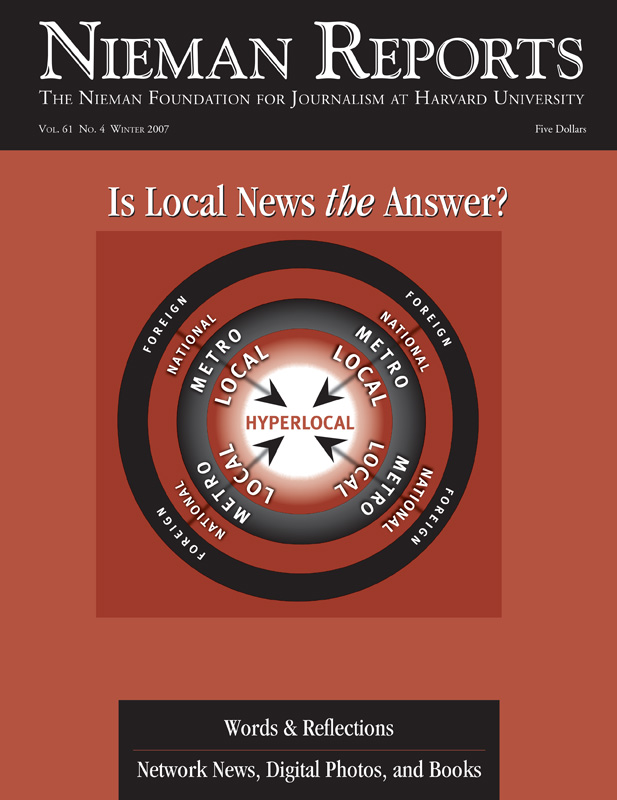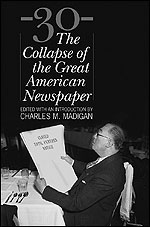The first time I walked into the newsroom of The New York Times there were paste pots and spikes on the desks of copyeditors. Reporters wrote on 10-part books, and stories were whisked to the composing room through pneumatic tubes. The staccato of hundreds of typewriters pounded in the daily dance of deadline. The linoleum floor was pocked black with the burns of thousands of ground-out cigarettes.
It was the summer of 1969, and I was smitten by the excitement, the creativity, and the energy of the newsroom. That summer also saw banner headlines proclaim “Men Walk on Moon,” announced a tragedy at Chappaquiddick, and a generation’s greatest party, called Woodstock.
I worked that summer as a copyboy and clerk on the national desk. After graduating from college a year later I started at the Times as a copyboy. Less than a year after graduating, in the spring of 1971, I was assigned as editorial assistant on The Pentagon Papers Project. The Vietnam War raged, and the adversarial relationship between the press and the Nixon administration was real and dangerous. There was Nixon’s enemies list and then the Watergate story broke and unraveled a presidency.
Was there ever a better time to be a young, idealistic journalist? There was romance and glamour and even valor in my chosen vocation. Every day I spent in the newsroom was an adventure, an opportunity. A boring day could become electric in a moment with a breaking story. And, best of all, it was fun.
That was all a long time ago. My career has been filled with adventures, triumphs and setbacks. And for the past 12 years I’ve had a ringside seat to the dismantling of an industry, a calling, a culture that I loved and am truly passionate about. Call me one of the dinosaurs. But after reading “-30-: The Collapse of the Great American Newspaper,” an anthology put together by Charles M. Madigan, a long-time journalist at the Chicago Tribune, I was not ready to be euthanized.
In his introduction Madigan lays out a premise I agree with:
“The business sits,” he wrote, “after all, at the intersection where truth and trouble collide, and that is a risky place. It searches every day for the doom and the delight that define life. It tells sad, happy, pointless, profound stories. It is inconceivable that it would disappear, but not inconceivable that to save itself it will change so much you may not recognize it.”
The book tracks, in 15 essays, the myriad reasons we know so well about what has happened to newspapers. It is not a pleasurable read. But it is an important anthology, with lessons learned and possible solutions. It has the feel of a campaign book for a lost war. And like a war, there have been many casualties. John Nichols, the Washington correspondent for The Nation in a piece published last January by that magazine, wrote, “More than 44,000 news industry employees, at least 34,000 of them newspaper journalists, have lost their jobs over the past five years.” This is a staggering number, and since that time at least hundreds, and probably thousands more, have left newsrooms across the country.
Energized for the Transition
Still, reading this book left me energized, as I think it will other journalists, as we try to figure out how best to utilize our skills, knowledge and leadership in developing a new journalistic model for the 21st century. The road ahead will be bumpy and challenging, but if we can adapt to the new dynamics and demands that technology presents to us—and find ways to weather some tough economic times during the transition—then the job of being a journalist will become even more valued in the years ahead.
Before I read Madigan’s book I believed the core of the problem for newspapers (the medium I am most familiar with) was a business model that demands and expects ever-growing profits. After reading this book, I am certain this is true. This is not an epiphany for me or any other journalist. Editors and publishers have felt for quite some time that the business model for newspapers is broken. But the response from the business side has been to hit their profit targets by cutting staff, expenses and reducing the news hole. While these moves pleased Wall Street analysts and shareholders, they have failed to increase revenue or led to true innovation.
Playwright and author Lillian Hellman, in “Scoundrel Time,” observed that during the period of the House Committee on Un-American Activities hearings, “Truth made you a traitor as it often does in a time of scoundrels.”
What was one of the important truths about newspapers—a truth well understood but perhaps not voiced as vigorously as it should have been? What I came to understand was that the creative culture of the newsroom was in nearly total conflict with the culture and values of the business side. Journalists were characterized as being naive, foolish, change adverse, and prone to spending a lot of the company’s money. But the best journalists are innovators and risk takers, with a tremendous sense of urgency. They are also highly ambitious.
The skills that journalists possess seem a perfect fit during this time of immense chaos and change in our business. Yet during the time when newspapers have been collapsing, top editors who had a say seemed rarely to be heard. Drastic strategic changes that some editors proposed were dismissed or ignored, often due to the potential their idea had for a short-term downturn in revenue. In truth, their ideas weren’t likely to be listened to when the core value of the company that owned their newspaper was increasing its profit margin and receiving a thumbs-up from Wall Street analysts.
The conflict of quality vs. profit has long been argued. In the summer of 1998, Columbia Journalism Review published a piece, included in this book, titled “Money! Money! Money! The Profits-Versus-Quality War.” In that article Neil Hickey asked: “But should news organizations reasonably expect the same profit levels as software companies, pharmaceutical firms, and computer makers? Or should stockholders and owners understand, when they wed their fortunes to those of working journalists, that news is a venture like no other? It’s the only business protected by the Constitution of the United States, a status that brings obligations for both the shareholder and the journalist.”
Envisioning New Models
The future will be different but with opportunities that are limitless for the work that journalists do. The Internet is a voracious beast, never satisfied with the amount of “content” it can offer. Sadly, the loss at news organizations of thousands of journalists means that what they could have contributed to these new models emerging on the Web won’t be a part of this change.
Yet a pressing need remains for the crucial and critical role journalists have long played in their public service capacities as news and information gatherer, watchdog and investigator. What journalists do has shaped history, explained complex issues, irritated those who abuse their positions of power, and delighted those who consume it. Today and into the future, with the help of the Web, emerging technologies and new partnerships, the impact, global reach and community engagement with what journalists do will be enormous. And the extent of journalism’s influence will be based—as it always has been—on its core values of credibility, quality and service.
What will new models look and be like? This book offers suggestions and vision, and I come away from reading it with the belief that the crucial element determining success will be the strength of emerging relationships among those whose money will support the journalistic enterprise and those who create the product. They will need to arrive at a sense of shared values and passion about what their journalistic enterprise is and the value it holds—not expressed in monetary terms alone. To use the term “news organization” does not begin to describe the potential opportunities I see ahead for these new ventures. “Publishing” partnerships will be formed and collaborations among news organizations—though these might look very different than we think of them today—will be crucial.
Creating these organizations—using a new DNA—will be easier than the slow transition we are witnessing today with the “old model” organizations. Energy increases when we become engaged in building something new instead of feeling demoralized as institutions we once valued so highly are being destroyed by our own cannibalization.
I have faith that new models of journalism are going to fly out of this whirlpool of change and be successful. Ten years ago Google wasn’t even in our vocabulary. Ditto Craigslist and Facebook and MySpace and YouTube.
Journalism, as practiced at newspapers, is not dead. But journalists will need to salvage what is essential, figure out how to transform it to the new media, and become leaders in this period of upheaval. It will take men and women of vision and deep pockets, whose primary catalyst is not profit.
“I believe a newspaper is a civic asset, a civic trust,” says Eli Broad in John Nichols’ contribution to this book. “I see a role for foundations that are not totally bottom-line oriented somehow being involved in the newspaper industry and/or civic-minded families and others.”
This idea offers a possible solution—one we already see being tried in several online journalistic endeavors—if journalists do not let the agendas of their funders influence their work and undermine the credibility of these new enterprises. There are these inherent risks, and they must be dealt with, since there is no other choice. I’d argue that we cannot, as a nation, continue to lose thousands of journalists or sit back and watch the daily erosion of journalistic work on which we, as citizens, rely.
As journalists, we live in a time of crisis—offering the possibility of historic change—as we witness a pillar of our democracy being wounded and withering away. Great urgency and risk taking is called for to stem the collapse of what newspapers have stood for in our country’s past. We have no other choice.
Robert J. Rosenthal is the former editor of The Philadelphia Inquirer and former managing editor of the San Francisco Chronicle. He hopes to contribute to building a new media organization that takes advantage of all of the opportunities that lie ahead. In January he will become the Executive Director of the Center for Investigative Reporting in Berkeley.



